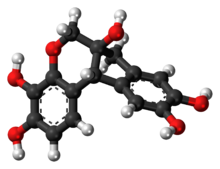Hematoxylin
 |
|
 |
|
| Names | |
|---|---|
|
IUPAC name
7,11b-Dihydroindeno[2,1-c]chromene-3,4,6a,9,10(6H)-pentol
|
|
| Other names
Hematoxylin; Natural Black 1; Hematoxyline; Hydroxybrazilin; Hydroxybrasilin; C.I. 75290
|
|
| Identifiers | |
|
3D model (Jmol)
|
|
| ChemSpider | |
| ECHA InfoCard | 100.007.490 |
| MeSH | Hematoxylin |
|
PubChem CID
|
|
| UNII | |
|
|
|
|
| Properties | |
| C16H14O6 | |
| Molar mass | 302.28 g·mol−1 |
|
Except where otherwise noted, data are given for materials in their standard state (at 25 °C [77 °F], 100 kPa).
|
|
|
|
|
| Infobox references | |
Haematoxylin or hematoxylin (/ˌhiːməˈtɒksᵻlᵻn/), also called natural black 1 or C.I. 75290, is a compound extracted from the heartwood of the logwood tree (Haematoxylum campechianum). Haematoxylin and eosin together make up haematoxylin and eosin stain, one of the most commonly used stains in histology. This type of stain is a permanent stain as opposed to temporary stains (e.g. iodine solution in KI). Another common stain is phosphotungstic acid haematoxylin, a mix of haematoxylin with phosphotungstic acid. When oxidized, it forms haematein, a compound that forms strongly coloured complexes with certain metal ions, the most notable ones being Fe(III) and Al(III) salts. Metal-haematein complexes are used to stain cell nuclei prior to examination under a microscope. Structures that stain with iron- or aluminium-haematein are often called basophilic, even though the mechanism of the staining is different from that of staining with basic dyes.
In the early 1970s and in 2008, there were shortages of haematoxylin due to interruptions in its extraction from logwood. The price of the compound increased, affecting the cost of diagnostic histopathology, and prompted a search for alternative nuclear stains. Before the use of any alternatives became firmly established, haematoxylin returned to the market, though at a higher price, and resumed its place in histopathology. Several synthetic dyes have been recommended as replacements, notably celestine blue (CI 51050), gallocyanine (CI 51030), gallein (CI 45445) and eriochrome cyanine R (also called chromoxane cyanine R and solochrome cyanine (CI 43820). All four have Fe(III) as the mordant. Another alternative is the aluminium complex of oxidized brazilin, which differs from haematoxylin by only one hydroxyl group.
...
Wikipedia
